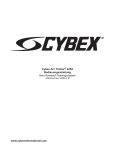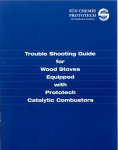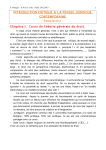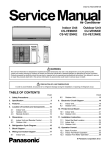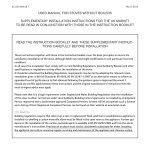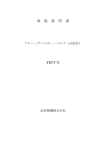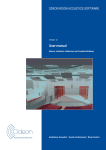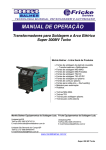Download Camina Art Moderne Specifications
Transcript
Utgåva 1.2006 w w w. c a m i n a . s e Instructions for assembly and use Art Suprême Art Grace Art Moderne 39 53 03 These instructions are also valid for product-type and environmental approval documentation purposes. Art Etage Art Pierre Contents Bear in mind that certain parts of the fireplace become extremely hot in the course of the combustion process, and take suitable precautions if there are children in the vicinity. You should also take into account that a space of at least 1000 mm must be allowed between the front of the hearth and combustible furnishings. General................................................... pages 3-4 -Receipt of goods -Cool hands -Manufacturer’s assurance -Planning application -Inspection -Guarantee -Chimney -Distance from combustible surfaces -Load-bearing structure -Fireplace base -What is included? -Log compartment plates -Base stone unit Assembly................................................ pages 5-6 -Important -The right location -Order of assembly for top connection -Top connection -Transport attachments -Connection to existing masonry chimney -Ball/plummet stop -Cutting hole in masonry chimney -Design specifications -Accessories/options Technical information...............................pages 7-8 -Combustion air supply -Air flow diagrammes -Outdoor air connection -Output control -Controls -Distance from wall surfaces -Ash disposal Dimensions and connection heights............ pages 9-11 -Camina Art Suprême -Camina Art grace -Camina Art Etage -Camina Art Moderne -Camina Art Pierre Instructions for use and maintenance............ page 12 2 General Receipt of goods Congratulations ve. of a Camina sto on your choice n was almost ultimate decisio ur Yo . us in ce l your positive having confiden t to confirm al an w e w Thank you for d an ade overnight, certainly not m expectations. n for a great imum satisfactio ax m ve of gi to red a high degree are manufactu logy provides no ufacch an te All our stoves m on gh sti hi ern combu erials and od at m M s. ity ar al ye qu y h en man y. Hig But ev ble operation. heating econom safety and relia efficiency and rmation e, fo lif in ng on lo d re se ensu ndling, ba ha d an turing standards re ca r require regula the best stoves . ur and know-how fore lighting yo ns carefully be tio uc ls, str ve in le e at es th ssive he u should read ble fuels, exce This is why yo such as unsuita es e which is not ak ag ist m m l da ia e spidly caus ra first fire. Potent n ca ce to the safety in an te mainten cular attention rti e pa y ag m pa and inadequa da se ea ssible r guarantee. Pl you to avoid po covered by ou since they help , ge pa al fin tructions on the tential risks. a and identify po you will have the hope that in ina u am yo C to w er ne nt of your r product ov fro ou in s nd ur ha ho w y no We many happ pleasure and great deal of stove. rely, Yours since Camina AB The product may have been damaged in transport, although this may not be apparent from the external packaging. It is important that you inspect the stove carefully and report any damage to the transport company within seven days. You should note visible damage immediately on the delivery note, in connection with receipt of the goods. On delivery, the stove is attached to a pallet with screws, under a wooden frame, and is covered with sheet plastic. Take precautions to avoid damage when unpacking and assembling the stove. Cool hands The stove glove supplied is equipped with a practical magnetic attachment. Always use the glove when you open the door to put on more logs, since the fire-door handle is hot. 3 General Manufacturer’s assurance This product has been manufactured in accordance with the type approval documentation, of which the instructions for assembly, use and maintenance form an intrinsic part. Planning application Before commencing a new installation of a stove and chimney in an area covered by town planning, you must notify the local planning authority. The planning and building office in your local municipality will provide further information. Inspection When installation has been completed, it must always be inspected by a chimney sweep before the stove is used, irrespective of whether it is connected to a new or an existing chimney. In order to avoid condensation, insulation material should be inserted over the connection hose. The next stage is to fit the log-compartment plates (see photo below). Guarantee Before using your stove, you should read the terms of the guarantee (see our website and/or the inside cover of our product catalogue), indicating the requirements that must be met if the guarantee undertakings are to apply. Chimney The diameter of the flue must be at least 150 mm, and we recommend a inimum flue height of 3.5 metres, measured from the stove flue-connection point. Follow the chimney supplier’s assembly instructions carefully. If you intend to fit your stove to an existing masonry chimney, it should first be inspected by a chimney sweep to check that it is in good order. The stove can be connected at either a 450 angle, or at a 900 angle, straight-back with a cleaning door, to a chimney approved for a maximum flue-gas temperature of 3500 C. Fitting the log-compartment plates. Distance from combustible wall surfaces The minimum distance from a combustible wall surface is 500 mm at the sides and 100 mm at the rear (see diagrammes on page 9). The minimum distance from furnishings in front of the stove is 1000 mm. If the stove is placed against a masonry chimney or a firewall installation, the space behind the stove may be reduced to 50 mm. Load-bearing structure A stove with a chimney does not normally require special foundations, and can be placed on an ordinary floor supported by wooden rafters. If you are uncertain, contact a chimney sweep for further advice and instructions. Fireplace base The sopestone-base unit, and the castiron base unit, which are optional extras, increases the connection height by 40 mm (see illustrations for the various models). Available for Camina Art Grace and Camina Art Etage. 4 The stove must be placed on a fireplace base consisting of concrete, natural stone, brick or glass with a thickness of at least 50 mm, or sheet metal with a thickness of 0.7 mm. The base must cover the entire surface under the stove and extend at least 300 mm in front of the stove and 100 mm at the sides. A fireplace base in sheet metal or glass is available as an optional extra. What is included? The delivery includes the stove and inserts for a top or rear connection. Options include a fireplace base and a connection kit for an existing chimney. An outside air-feed connection and a fan are also offered as optional extras. Impotant! Study the user instructions carefully before using the stove and remember that the installation must be first approved by a chimney sweep. The right location Assembly Ball/plummet stop When you are deciding where the stove is to be placed, it is important to select a central location in your house in order to ensure even distribution of heat. If you are also planning to install a chimney, it is an advantage if the chimney exit point is as close to the roof ridge as possible, since this entails both aesthetic and cost benefits. If there is a floorlevel above the stove, you should also think about how the chimney is to pass through it. A cupboard or a corner area is often a good location for a flue shaft. The floor surface on which the stove is to rest must be even and horizontal. Order of assembly for top connection Follow the chimney supplier’s instructions carefully. Assembly is accomplished in the following order: 1. Prepare air-feed to the hearth (if required). 2. Cut hole in ceiling. 3. Install the fireplace base. 4. Lift the stove into position and fit the top stone unit in place (where applicable). 5. Fit soapstone units and top grill (where applicable). Assemble the chimney. If a top connection is employed, it is important to ensure that the plummet stop is fitted inside the stove insert. The plummet stop prevents damage to the flue baffle during chimney-sweeping operations. Top connection to the Camina NVI 2000 chimney kit Start by fitting the adapter pipe, using stove sealant (see photo). The next stage is to fit the connection piece and the flue modules, in accordance with the chimney manufacturer’s instructions. If there is a gap between the stove and the connection piece, insulate it with carbwool, rockwool, or a similar material. Then insert the flue pipes to achieve a tight fit against the stove. The top stone unit and the cast-iron grill must be fitted before the flue pipes are assembled. In the case of the Art Modern model and the Art Pierre model , the entire soapstone casing must be fitted at this stage. The Art Étage and Moderne model is equipped with a front grill and has no top grill. The Camina Art Pierre model with a top connection to the NVI chimney, featuring a grey-coated initial section and a curved fireplace base in toughened glass. 5 Assembly Cutting a hole in a masonry chimney Connection to an existing masonry chimney The stove is approved for a rear connection to a chimney with a ½ brick connection point which is approved for a 3500 C flue-gas temperature. 1. Measure where the hole is to be made in the chimney. Mark the hole and chisel it out so that it is slightly larger than the diameter of the chimney insert, allowing sufficient space to cement the insert in place, using mortar. Cement the insert into the hole. The stove is normally supplied for a top connection. If you intend to employ a rear connection, use the rear-connection cover plate instead to replace the insert on top of the stove. Apply stove sealant to ensure a good seal between the stove and the cover plate. Chimney insert Fit the connection pipe which is to be fitted into the chimney insert over the stove connection insert. Apply a thin layer of stove sealant around the insert before fitting the connection pipe. As an alternative to a straight rear connection, you can use a top/rear connection to a masonry chimney. In this case, the angle must have an inspection door to permit cleaning. When connecting the stove to a proprietary modular chimney, follow the manufacturer’s instructions. 1. 2. Design requirements The stove and the chimney must be arranged in a way that ensures that they cannot start a fire in adjoining fixtures or parts of the building. The flue must be installed in a manner which permits chimneysweeping for the full flue length, and with ready access to cleaning doors. 6 Place the floor plate/fireplace base in position. If you are going to connect the stove from the top into the masonry chimney, the loose top stone unit should be placed in position before the flue pipe is fitted. 3. Apply stove sealant to the stove insert and push the flue pipe into position. The stove is then placed in position and the flue pipe is cemented in place. If you are using a chimney insert, tamp in packing fibre around the flue pipe. Check that the distances are correct. Design specifications Colour Glass, ceramic Door Grate Hearth base Hearth lining Senotherm Withstands 7000 C Sheet steel Cast iron Cast iron Vermiculite The hearth is approved for a chimney with a ½ brick connection (3500 C), and the stove is designed for a chimney draught of at least 12 pa, as provided by a chimney with a minimum length of 3.5 metres and a cross-section of 150-200 cm2 (diam. 150 mm). Output Nominal output Efficiency (SS-EN 13240) Weights: Camina Art Suprême Camina Art Grace Camina Art Étage Camina Art Moderne Camina Art Pierre 2-8 kW 5.5 kW 70% Flue-pipe diameter Product-type and environmental approval CE-approval 150 mm 39 53 03 0402 122 124 124 210 190 kg kg kg kg kg Optional extras Outdoor air connection Diam. 60 mm Fan 240 V Soapstone base (only for Grace/Etage) 15 kg Cast iron base (only for Grace/Etage) Floor protection, straight or curved Toughened glass Floor protection, straight or curved Grey sheet metal The air consumed in the combustion process has Secondary air feed (unregulated) to be replaced, particularly in well-insulated buildings. The air feed to the hearth may be direct, via an outdoor air connection, or indirect, via a 3EKUNDËREJREGLE RBARFÚRBRËNNING SLUFT vent in an external wall. In the case of an outdoor air feed, the stove connection point has a diameter of 60 mm (see the diagrammes below for various configurations for outdoor air-feed solutions). Combustion air supply If the air channel passes through a warm area it should be insulated to prevent condensation. The minimum mineral-wool insulation thickness is 30 mm, with plastic foil on the outside. Anticondensation lagging may also be used. The drawing to the right shows the way in which air used in the combustion process passes through the stove. The combustion air feed is regulated by means of a control located under the stove door. This is the ”primary” air-feed control, and it should be fully or partially open during the combustion process (see instructions on page 12). This ensures that air passes over the glass surface and mixes with flue 0RIMËRREGLERBAR FÚRBRËNNINGSLUFT gases, and this in its turn contributes to the combustion process. The air feed to the after-burning process (secondary combustion) enters the stove at the bottom of the stove, to the rear, and then passes to the hearth backplate. The secondary air supply cannot be regulated. Primary, regulated air feed Integrally moulded into concrete foundation slab. Through the outer wall. This involves making a hole at the weak point in the base. Foundations with under-floor ventilation. Indirectly, via a vent in the outer wall which can be closed when not in use. Open Outdoor air connection Output control When the control is to the right, the primary air feed is fully open. Closed When the control is to the left, the primary air feed is closed. Economy position When the control is in this position, an economy output of 3-4 kW is normally achieved. Nominal position With the control in this position, a nominal output of 5.5 kW will normally be achieved (1.5 kg birch wood in the form of 3 logs). 7 Distances from wall surfaces Fire barrier Combustible wall, corner and straight-wall locations Ash disposal To access the ash tray, open the stove door by pulling the handle on the right towards you. Open the grate by holding the front edge of the grate and pulling it towards you by about 1-2 cm. When the grate is open you can rake the ash down into the ash tray. When the ash tray is emptied, make sure that there are no glowing embers. The ash must be stored in a fireproof container for at least 24 hours before disposal. 8 448 157 91 The Art Suprême model has two side glass panels to ensure a very broad angle to allow firelight in the room. This is a small, efficient stove which calls for minimum floor space. It is finished in an elegant graphite-grey. A top stone unit is supplied as standard. 311 861 1054 Camina Art Suprême 510 Placing the top stone unit and the top grill in position. The Art Grace model has a practical warming compartment - for example for heating up bread or defrosting buns. This is a small, efficient stove which calls for minimum floor space. It is finished in an elegant graphite-grey. A top stone unit is supplied as standard. A base stone unit or the cast-iron base unit are available as optional extras. 448 157 91 311 861 1184 (1224) Camina Art Grace 506 Placing the top stone unit and the top grill in position. 9 861 The Art Étage model has soapstone panels on two levels, and a decorative front grill. This is a small, efficient stove which calls for minimum floor space. It is finished in an elegant graphite-grey. A top stone unit is supplied as standard. A base stone unit or the cast-iron base unit are available as optional extras. 1164 (1204) Camina Art Etage 448 157 311 91 508 Place the lower top stone unit in position. Use the screw kit to attach the front grill, and then place the upper stone unit in position. 448 157 91 341 901 The Art Pierre model has a heat-storage soapstone casing. This is a small, efficient stove which calls for minimum floor space. It is finished in an elegant graphite-grey. 1094 Camina Art Pierre Soapstone casing components 506 10 Start by fitting the base stone unit, before lifting the stove into position. Assemble the sidepieces. They are held in position with the pins provided. Place the top stone unit in position, fastening the sides and the top with the pins provided. The two front sidepieces rest on a spring with an oval hole which is adjustable sideways. Camina Art Moderne The Art Modern model has a heatstorage soapstone casing. This is a small, efficient stove which calls for minimum floor space. It is finished in an elegant graphite-grey. Soapstone casing components Start by fitting the base Assemble the sidepieces in stone unit, before lifting the shown order. Applicate siliconen on stone/stone and stone/ stove into position. stove unit. The sidepieces will be held Assemble all the lower sidepie- The silicon should be about 3 in place by the silicon. Dont ces befor starting on the upper cm in diameter. forget to put silicon on the pieces . base stone unit. Assemble the sidepieces all Place the lower top stone unit Use the screw kit to attach the the way up and glue stone/ in position. Prepair the fluepipe front grill, and then place the upper stone unit in position stone and stone/stove unit. and chimney connection!! and glue stone/stone. 11 Instructions for use and maintenance The key factors for satisfactory operation of your new stove are proper installation and compliance with the user instructions. If you use the stove in the right manner, it will last for many years. Fuel The best heating results are achieved if you use split birch logs (or most other types of deciduous wood), since they burn more steadily than coniferous logs. If you use oak, beech or other type of logs with a high heat content, you should always mix them with other types of wood to avoid potential damage to the stove. The logs should be dry (approx. 20% moisture content) and of the right size (about 320 mm long with a diameter of 50-80 mm). In normal use, 1.5 kg of wood per hour is appropriate, with a maximum permissible quantity of 1.8 kg per hour. The Swedish Testing and Research Institute (SP) has concluded that optimum results are achieved at 1.3 kg of wood per 45 minutes. In the economy setting, an output of 3-4 kW is normally achieved when the stove is loaded with 1.5 kg of wood in the form of 3 logs. Please note that this hearth is only designed for logs. It is not appropriate to use alternative fuels such as pellets. It should also be noted that it is forbidden to burn timber containing preservatives, paint or adhesives, chipboard, plastics, and coated paper such as colour brochures. During the combustion process, these materials release substances which are hazardous to health and may damage the stove. They can also attack the steel in the flue pipe and the mortar in a conventional masonry chimney. Lightning a fire • Open the door and place the logs in a crosswise horizontal position. Start with small, dry sticks, on a layer of firelighters or screwed-up newspaper. The grate should be in the closed position. Leave the door slightly open for 5-10 minutes until the fire has taken hold properly. This also ensures pre-warming of the glass and helps to avoid soot formation. • When the fire has taken hold, close the door and open the air- feed control fully to the right (see page 8). • Larger logs with a cross-section of 50-80 mm can then be inserted. • After a while, when the fire has really got going, it may be necessary to reduce the heat. Reduce the combustion rate using the air-feed control (see page 8, Output control) • The volume of combustion air and the heat output depend on the type of wood used, the moisture content, the type of chimney and the flue-draught (chimney length in relation to the negative pressure in the building). It does not take long to learn how to use your stove to achieve maximum benefit and optimum heating results. Fuel replenishment • When you put more logs on the fire, you should open the door slowly to avoid smoke gusts. • Level out the embers before inserting new logs. This makes it easier for the new logs to catch fire. • Put on 2-3 logs, and do not reduce the air supply until the logs have caught fire. Never put on fresh logs when the fire is already burning satisfactorily. Everyday use • Light the fire as before, and adjust the air feed to achieve the output required. Worth knowing • When the using the stove for the first time, a slightly unpleasant smell may be noted. This is due to oil or paint residues in the hearth. The smell will disappear after the fire has been lit a few times. • Check the door sealing gasket at regular intervals. If it is damaged, it should be replaced. • Keep the hearth and the flue clean. If you use the stove frequently, you should sweep the chimney in the interval between regular visits by the chimney sweep. • If the outside temperature is low when you light a fire, it is a good idea to set fire to some paper and push it up into the chimney. This warms up the flue and improves the draught. • A coating of soot on the glass surfaces probably means that the hearth has not reached the right temperature. One reason may be damp wood. Wiping the glass with dry paper may be sufficient in some cases. If the soot deposit has been there for some time, the best solution is to remove it with detergent or a special soot-removal product. Alternatively, a normal oven-cleaning product can also be used. Never use a cleansing agent that contains an abrasive compound since this could damage the glass. • When the ash tray is emptied, make sure that there are no glowing embers. The ash must be stored in a fireproof container for at least 24 hours before disposal. Box 225 · 591 23 Motala www.camina.se • If a chimney-fire occurs, or if there is a risk of a chimney-fire, close the air-feed control and the door. If necessary, contact the fire brigade to have the fire extinguished. The chimney must always be inspected by a chimney sweep after a chimney-fire has occurred.












